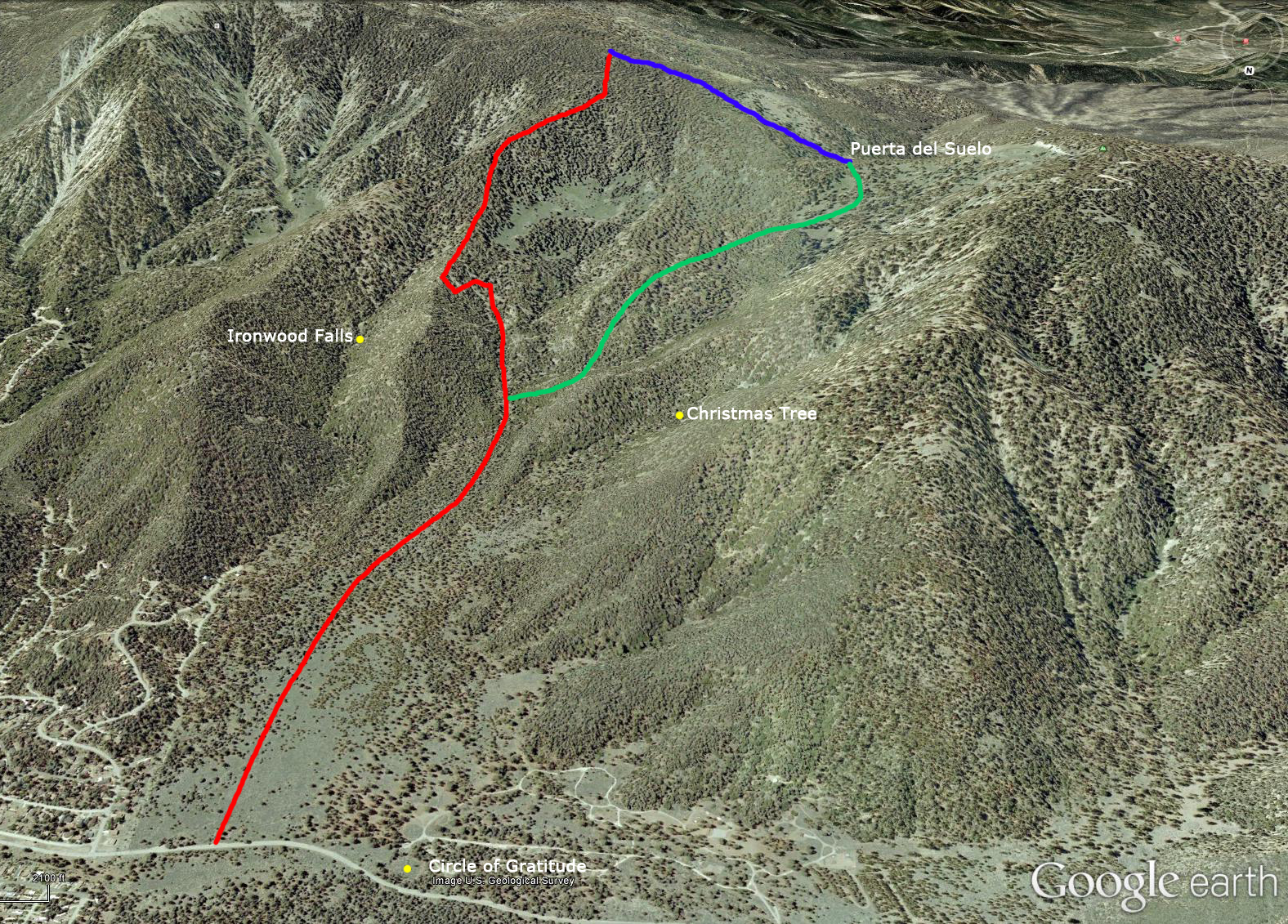
Direct Ascent to Grouse Mountain from PMC
(30th August 2014)

Hiking companion, Chris, and I did an interesting loop from the Smokey the Bear sign just to the west of PMC directly up the side of Grouse Mountain. We left late in the day (3:45 pm) and intersected the Tumamait Trail after dark (7:30 pm). This is the climb shown in red above which took 3.75 hours at a leisurely pace. The key to this route going up is to find the easiest place to mount the ridge since it is both steep and the surface underfoot tends to be unstable. The other concern was not to walk over the Tumamait Trail without realizing you have crossed it which would be very easy to do in the dark.
We then followed the Tumamait Trail (shown in blue) down to the bottom of the Puerta del Suelo saddle where you find the turn off to Mesa Spring (sign posted). One interesting observation in this particular stretch was my two dogs had no trouble following the Tumamait Trail in the complete dark. My conclusion is dogs follow trails (be it animal or human) largely, or even entirely, by smell and can do this without any visual reference. It makes me wonder if dogs also do this to a large extent during the day as well and the visual reference is possibly an adjunct to navigating their way. I've noticed that dogs are always extremely good at following trails.
From the the bottom of the Puerta del Suelo saddle we left the trail going right and descended on another spur (shown in green) back down to the starting point at the Smokey the Bear sign arriving there about 9:30pm. So the loop took nearly 6 hours with the final two hours (basically the entire descent) in the dark. Chris had descended this spur before in the dark so I had a good guide (I would have been pretty bamboozled otherwise). We had flash lights which we used as needed but tried to hike by natural light (moon light) as much as possible.
Night hiking is a little quirky and not everyone's cup of tea. If you don't like the sound of it then no need to do it of course. Although it does provide some experience with this type of hiking should you ever need this skill because you get lost or injured and need to return after dark. It can be a serene experience although I have to admit I always feel more nervous hiking at night compared to during the day. But I do enjoy it in a perverse sort of way.


The beginnings of a dramatic sunset.
It is very easy to get lost trying to navigate off-trail hikes like this (I mean during the day...I'm not talking about night hiking now). So an already challenging hike can suddenly become many times more difficult, arduous and possibly dangerous. At a minimum, you need above average navigation skills and a good sense of being able to reliably read the lay of the land. Also to stay calm and not panic or behave erratically when things don't unfold as you had assumed they might.
Especially when hiking off-trail for the first time in unfamiliar territory, I'd recommend you hike with a guide who knows the way and/or carefully plot the route beforehand on a topo map and use GPS waypoints to follow a pre-planned, optimal route.
I know experienced hikers who travel these routes alone but I strongly recommend hiking with one or more companions. If one of you gets into trouble the other can assist or even go for help if necessary. Also pairs or groups of hikers rarely have problems with wild animals although the risk is very low even for solo hikers. Taking medium-to-large-size, healthy dogs helps in this regard as well.
Don't take any risks that might lead to physical injury. Be extra careful and extra diligent, even more so than you would normally.
Very importantly, always tell a reliable person (or a number of friends) the time you are setting out, where you are going, and when you expect to return. If you don't show up then there is a better chance that Search and Rescue can find you quickly and efficiently and be able to offer assistance. Don't forget to let everyone know when you are back safely so they don't raise the alarm unnecessarily.
If you follow the most efficient route by sticking to the tops of ridges, this should be a relatively straight forward (although long) hike taking about 6 hours. But if you get lost or go the "wrong" way, the time needed to get back to civilization could double, or triple, or even more in the worst case scenario.
![]()
Peter Gray
telephone: +1 (661) 242-1234